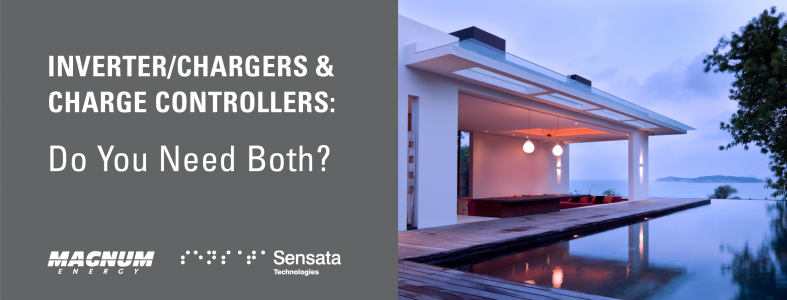
What’s the difference between an inverter/charger and a charge controller, and do you really need both? Read on for answers to this and other questions about PV + storage solutions, both on- and off-grid.
In a typical PV system, the inverter/charger accomplishes two basic tasks: 1) converts DC power from the batteries into household AC that can power standard appliances and other energy loads, and 2) converts AC into DC energy that can charge deep cycle batteries. This two-way exchange of energy is crucial for efficiently storing and using energy harvested by PV systems.
Hybrid inverter/chargers such as the MSH-M also allow multiple AC sources, such as a generator or the grid, to charge batteries. Whether you live off-grid and have cloudy days, or have utility power and the grid goes down, the inverter/charger can provide reliable and ready power.
By contrast, a charge controller sends power in one direction, charging deep cycle batteries from the power generated by solar modules and preventing the current from draining back into the PV array at night.
Charge controllers come in two formats, PWM and MPPT, and may have a variety of other features as well.
For example, the PT-100 from Sensata is a MPPT solar charge controller with a battery temperature sensor, LED system information screen, and multiple electronic overcurrent protections. PWM (Pulse Width Modulation) and MPPT (Maximum Power Point Tracking) refer to how the charge controller modifies voltage in order to effectively charge batteries from a PV system.
In most cases the MPPT style charge controller, such as the PT-100, is the better choice, capturing PV energy far more efficiently and allowing for more flexible configurations of solar panels and batteries.
Almost all PV + storage applications require both an inverter/charger and a charge controller.
On the one hand, while MPPT charge controllers provide optimal charging efficiency, the light from the sun may still not be enough to reliably charge batteries in winter or during bad weather. Many power loads also require standard AC current. For both these reasons, an inverter/charger is required to keep batteries adequately charged and provide power that can be widely used.
On the other hand, inverter/chargers are not equipped to directly charge batteries from the DC current provided by a PV array. A charge controller is needed to appropriately match the PV voltage to the battery and regulate charging.
There are few exceptions.
In some PV + storage applications you may only need a charge controller. This occurs when all your power loads only accept DC current and your PV array can reliably charge your batteries all year long.
In PV systems without batteries, in which you want to connect to the grid – commonly called interconnection – look for an inverter designed and listed for interconnection. In storage/backup systems without PV, you only need an inverter/charger to connect the system.

Still have questions about inverter/chargers or charge controllers? Contact a Sensata representative. For more general information on what you need for cutting-edge PV + Storage systems, check out the inverter/chargers, charge controllers, and accessories available now from Sensata.

